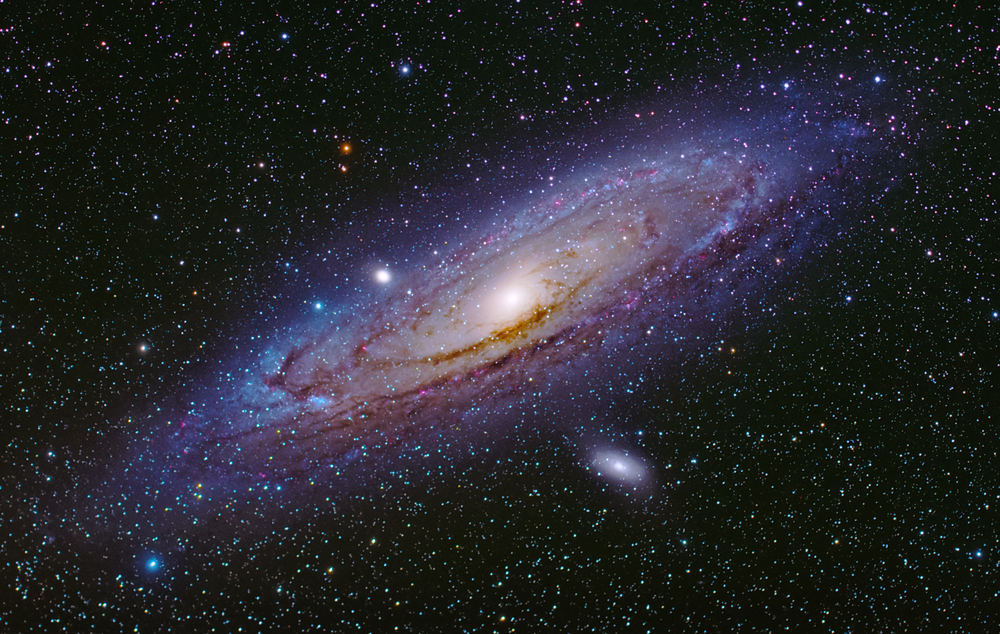
We are not alone—at least as a galaxy. About 50 dwarf galaxies surround the Milky Way. But when its intense gravity inevitably draws them to venture too close, they will probably be annihilated. It’s happened before.
Though scientists used to think that all those dwarf galaxies orbiting the Milky Way were going to stick around for tens of billions of years, that might not be the case. “Most dwarf galaxies are star systems that arrived late in the Milky Way… in sharp contrast with a long-term satellite hypothesis,” an international team of researchers said in a study recently published in Monthly Notices of the Royal Astronomical Society.
Based on data from the European Space Agency’s Gaia mission, this study has found that many dwarf galaxies that were orbiting the Milky Way only a few billion years ago have ended up destroyed after being pulled in by our much more massive galaxy. It is possible dark matter has something to do with this.
The researchers used Gaia data to date objects within the Milky Way that originated in smaller galaxies that had previously been swallowed. By identifying galactic remnants, they determined that most dwarf galaxy remnants within the Milky Way only entered it within the last 3 billion years or so. When these galaxies crashed into our own, there was so much turbulence that they lost their gas, and their structures were drastically changed.
A matter of dark matter
The destruction experienced by the dwarf galaxies that entered the Milky Way brings the amount of dark matter in these galaxies into question. If they were rich in dark matter, the mass and gravity of that dark matter would have helped keep most objects in their orbits even in the face of some disruption. In other words, the dwarf galaxy would remain a coherent object even after being incorporated into the Milky Way.
That’s not the case, which probably means those galaxies were lacking in dark matter. If dwarf galaxies currently orbiting the Milky Way are also dark-matter deficient, they could also end up being eaten alive in the future.
The finding raises an additional question. Physics indicates that the dwarf galaxies orbiting the Milky Way should be rich in dark matter. But if there was as much dark matter in these galaxies as predicted by classical physics, it would probably hold them together strongly enough so they would make it past the halo mostly intact.
Until recently, galaxies that the Milky Way has absorbed were thought to have orbited for many billions of years longer than they actually had. This is because the previous thinking was that these galaxies were full of dark matter. That dark matter would have protected these galaxies as the Milky Way’s enormous gravitational pull threatened to tear them apart.
Those galaxies that have already been absorbed by the Milky Way predictably have less orbital energy than galaxies still outside the Milky Way. Orbital energy is the gravitational potential energy and kinetic energy of an object in relation to the same qualities of the object it orbits. Galaxies with the least orbital energy are thought to have merged farther back in time since their stars are presently scattered farther from each other.
For example, the dwarf galaxy Sagittarius entered the Milky Way around 5 or 6 billion years ago. It was an elliptical galaxy, but its present remains are not very structured, and its objects have widely varying velocities. This disruption is consistent with a relative scarcity of dark matter.
Trying to shed light
Dark matter is invisible and undetectable—its presence can only be inferred. So estimating the dark matter content of dwarf galaxies that have been absorbed by the Milky Way is extremely difficult, because there is no way to get a read on their dynamical mass, which is measured by the movement of objects in a galaxy.
If objects in these galaxies had stayed in the same orbits they were in before absorption, it would be possible to infer dark matter content. The problem is that the velocities and orbits of the stars in absorbed galaxies have been altered by interactions with Milky Way objects. Therefore, there is no way to make this estimate given the chaos of a galaxy that has been disrupted.
The stars in dwarf galaxies that entered the Milky Way a few billion years ago have been flung far from their galactic cores. Almost nothing is in order anymore. While the researchers think there may be some other way to at least get an idea of how much dark matter may have been in these galaxies, for now, we are in the dark.
Monthly Notices of the Royal Astronomical Society, 2024. DOI: 10.1093/mnras/stad2922



3175x175(CURRENT).thumb.jpg.b05acc060982b36f5891ba728e6d953c.jpg)
Recommended Comments
There are no comments to display.
Join the conversation
You can post now and register later. If you have an account, sign in now to post with your account.
Note: Your post will require moderator approval before it will be visible.